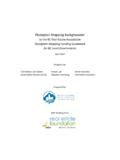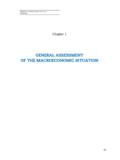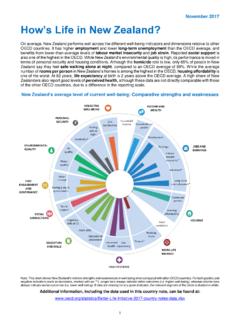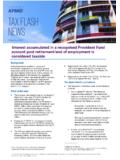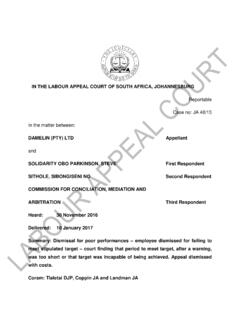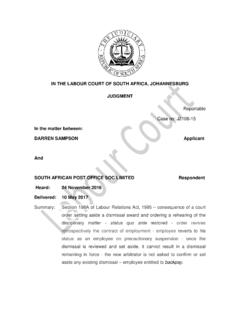Transcription of SLOWER GROWTH EXPECTED FOR ECONOMY AND …
1 housing forecast Fourth Quarter November 2 0 17 STRONG ECONOMY VERSUS housing HEADWINDSM ultiple Listing Service (MLS ) residential sales in the province are estimated to reach 102,350 units this year, a decline of nearly 9 per cent from a record 112,200 unit sales in 2016. MLS residential sales are forecast to decrease a further 10 per cent to 91,750 units in 2018. housing demand is EXPECTED to remain above the ten-year average of approximately 85,000 units through 2018. The BC housing market is being supported by a strong-performing ECONOMY and corresponding employment GROWTH , as well as associated consumer confidence. The BC ECONOMY is forecast to expand by per cent this year, the fourth consecutive year of 3 per cent or more real GDP GROWTH .
2 The cumulative effect has fueled employment GROWTH to its strongest performance in almost 20 years. Since January 2015, the province has added nearly 180,000 jobs. This has bolstered consumer confidence, with retail sales in BC EXPECTED to increase by an extraordinary 9 per cent this year. While provincial economic conditions appear to be on a sound footing, the housing market will face increasing headwinds in 2018. A rising interest rate environment will certainly erode affordability in the new year, while tougher mortgage qualifications for conventional mortgagors will reduce their purchasing power by up to 20 per cent. In addition, the high level of net migration from other provinces, especially Alberta, over the past few years is EXPECTED to wane, which will slow overall population GROWTH .
3 These factors will likely be exacerbated by home prices that are already elevated after several years of significant rates of GROWTH . The supply of homes for sale is now trending at or near decade lows in most BC regions. The imbalance between supply and demand has been largely responsible for rapidly rising home prices. While slowing demand will help alleviate these conditions, the expansion of the housing stock is necessary to slow the ascent of home prices. There are now over 56,000 units under construction in the province, up 54 per cent over the last 24 months. Many of these units will be completed in 2018, adding much-needed supply to the market. The combination of slowing housing demand and a rising inventory of homes for sale is EXPECTED to move the market toward balanced conditions next year, and lead to less upward pressure on home Outlook.
4 2 Vancouver Island-Coast ..4 Lower Mainland-Southwest ..6 Thompson-Okanagan ..8 Northern BC ..10 Kootenay ..12 Tables ..1322 BCREA housing forecast November 2017 The BC ECONOMY is enjoying almost unprecedented GROWTH , rivaled only by the economic boom of the mid-2000s. Economic GROWTH , as measured by real GDP, is forecast to reach per cent in 2017, the fourth consecutive year of GROWTH above 3 per cent. This prolonged period of economic GROWTH has fueled the strongest employment GROWTH in almost 20 years, trending near 4 per cent. As a result, the provincial jobless rate is at its lowest level in nearly a decade. However, there are several reasons why the current pace of GROWTH may not continue. First, economies that have experienced long periods of above-trend GROWTH tend to bump up against capacity constraints, particularly in the labour market where low unemployment is a signal of a fully utilized labour force.
5 High levels of international and interprovincial migration have helped drive labour force GROWTH . However, GROWTH from net migration probably can t be pushed much higher. Second, rising interest rates and tougher new mortgage regulations will slow consumer spending and housing demand. The Bank of Canada raised its overnight interest rate twice this year, bringing its key policy rate back to ECONOMIC OUTLOOK 1 per cent. Canadian borrowing rates have risen in turn, with contracted 5-year fixed mortgage rates now above 3 per cent for the first time since 2014 and the 5-year qualifying rate approaching 5 per cent. Higher interest rates make the burden of elevated household debt more onerous, meaning a tightening of household budgets and SLOWER GROWTH in consumption spending.
6 The sudden change in monetary policy is not due to higher inflation, which has yet to materialize, but rather stronger GROWTH in the Canadian ECONOMY . Further rate increases are likely over the next year, which are EXPECTED to push the average 5-year fixed mortgage to per cent and the 5-year mortgage qualifying rate to per cent by the end of 2018. BC Economic Outlook20162017F2018 FReal GDP GROWTH (%) Employment (millions) Employment GROWTH (%) Unemployment (000s) Unemployment Rate (%) Personal Disposable Income ($billions) Personal Disposable Income GROWTH (%) Average Weekly Weekly Wage GROWTH (%) Retail Sales ($billions) Retails Sales GROWTH (%) Range of Posted 5-year Fixed Mortgage : BCREA Economics, Statistics Canada13 BCREA housing forecast November 2017 Compounding the impact of tighter monetary policy, the Office of the Superintendent of Financial Institutions (OSFI), the federal banking regulator, announced further restrictions on mortgage regulations that come into effect January 1, 2018.
7 All non-insured borrowers (those with at least a 20 per cent down payment) will need to qualify at either the posted 5-year fixed mortgage rate or their contract mortgage rate plus 200 basis points, whichever is higher. While we expect these new qualifying rules to slow home sales, home prices may not be affected as a result of low existing supply in the , a moderate rise in the supply of homes will help bring the housing market closer to balance between demand and supply. Some of that supply will originate from long-awaited completions of housing units in the pipeline for several years. There are approximately 56,000 residential units under construction across the province, including 39,700 units in the Metro Vancouver area. As these homes are completed, the housing stock will expand at an elevated pace, providing much-needed supply for consumers.
8 Finally, uncertainty around NAFTA has the potential to endanger strong GROWTH in the BC manufacturing and export sector. BC manufacturing sales are up per cent in 2017, while the dollar value of exports is up nearly 18 per cent. However, higher Canadian interest rates have pushed the Canadian dollar higher, contributing to SLOWER overall export GROWTH in Canada. Meanwhile, the forestry sector is grappling with US-imposed softwood lumber tariffs. Its impact has reversed a previously robust recovery in the sector. With ongoing uncertainty over the future of NAFTA, further negative consequences for the BC trade sector could be forthcoming. Given these potential headwinds, we expect economic GROWTH in the province to slow next year. The BC ECONOMY is forecast to expand at the SLOWER , but respectable, rate of per cent in 2018.
9 While that rate of GROWTH is a step down from the greater than 3 per cent heights of the past four years, the provincial ECONOMY will continue to be supported by favourable demographics, a robust labour market and a well-diversified ECONOMY . 24 BCREA housing forecast November 2017 The Victoria, Vancouver Island and Powell River real estate boards service the Vancouver Island-Coast region of the province. housing demand has remained elevated in the region, as a strong performing ECONOMY has induced employment and population GROWTH , as well as consumer confidence. Surging employment in both Greater Victoria and the entire Vancouver Island-Coast region over the past two years has helped underpin housing demand. In addition, migration to the region has increased significantly over the last several years.
10 Households are drawn by the region s hospitable climate, relative affordability and burgeoning employment opportunities. Retirees are also an important factor, as Vancouver Island communities have some of the highest concentrations of seniors in the province. VANCOUVER ISLAND-COAST On the negative side, there has been a pull-back in tourism as a relatively strong Canadian dollar has made international visits more expensive. However, with the loonie now falling against the US greenback, look for a recovery in this sector in 2018. After last year s record-breaking performance, Multiple Listing Service (MLS ) residential sales are EXPECTED to be down by 16 per cent this year in Victoria and nearly 9 per cent on Vancouver Island. However, 2017 will still mark one of the strongest years of housing demand ever recorded for the region.




